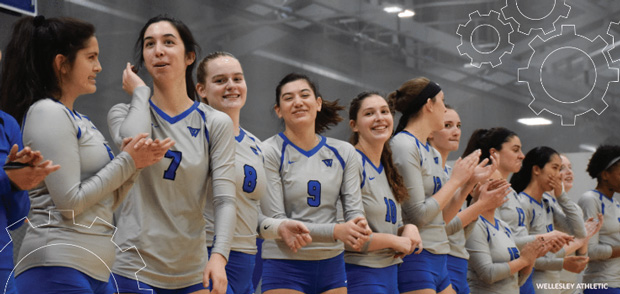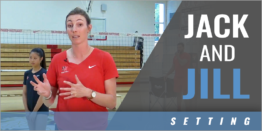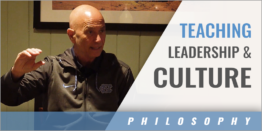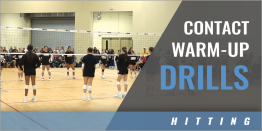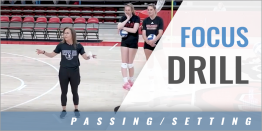|
By: Dorothy Webb - Head Volleyball Coach, PERA Professor of the Practice - Wellesley College Provided by: American Volleyball Coaches Association
In college, my teammates and I had our own sports psychologist. We were the #1 ranked volleyball team in the country for most of my four years, and we won two DI National Championships. Our very own team psychologist was apparently one of the perks of so much success. However, most of my teammates and I didn't think we needed any psychological help, at least not in the areas of competitive drive and optimal performance level. Our record over four years was 133-18. We routinely beat UCLA, Stanford and Nebraska. We played on ESPN and in front of huge crowds. Mostly though, we won. What else did our coach want us to do and what were we supposed to be getting out of sports psychology training? Did he think we weren't winning by enough points? Was he fulfilling some kind of "mental training" mandate by our athletic department? We really didn't know, but we didn't agree that we needed weekly sessions with a team therapist (as we affectionately referred to him). Our sports psychologist lectured us in beginning visualization, asking us to "taste" and "smell" an imaginary orange with our eyes closed. He passed out questionnaires asking about our "internal critic" and our "optimal arousal state" (which resulted in a lot of giggling from the back of the room). He talked about "blocking out" all outside noise and "external stimuli." I listened patiently to most of this and filled out his questionnaires honestly, for the most part. But on my best days I was bored and on my worst days I was annoyed. Our team continued to win, performing especially well in big matches against USC and Texas, and I was quite certain that none of our success was due to our sports psychology training. Even on the rare occasion when we lost a match, we knew it wasn't because we had forgotten how to breathe "diaphramatically," or hadn't been able to visualize winning a particular point, or had failed to reach our "optimal arousal state." Although my college teammates and I weren't stupid, for the most part, we were extremely one-dimensional in our focus; we just wanted to be pointed in the direction of the court and the ball. Along with our dismissal of traditional sports psychology training, we were impatient with long speeches, any mention of pre-game relaxation, or extended information in time-outs; all we wanted to do was play - and win - and all this extra stuff caused annoying delays. In fact, we were so serious and competitive at the Final Four at the University of Michigan my sophomore year in our semifinal match against UCLA, that our coach, John Dunning, began the tradition of telling us jokes at the end of timeouts. He had learned from our sports psychologist that smiling and laughing have the physiological effects of lowering the heart rate and slowing the breathing, and he apparently decided to give it a try. We teased him later that if only his jokes had actually been funny, the strategy might have worked. But, it turned out, we won a national championship that year. Ironically, my own intense playing experience, including a professional career after college, left me ill-equipped to coach and teach mental toughness to others. My inability in this area was especially inconvenient as I accepted the head coaching job at Brown University while in graduate school, and moved on several years later to coach at Wellesley College, a small, elite, all-women's college with a Division III athletic program. Everyone, including my athletic directors, my players, their parents and my incoming recruits, assumed that I could teach and coach all aspects of the game, especially mental toughness. I assumed this was true too. I was wrong. In my early coaching years, only a few of my more skilled, experienced players were truly excited and confident for the "big" conference matches, post-season play-offs and NCAA tournament games. Many of my athletes were extremely tense - and sometimes miserable - and I even had a few who hyperventilated and/ or ran off the court (and out of the gym, I assume) during a match! I suppose I had believed that my own ability to compete under pressure would, by some sort of magical osmosis, transfer onto my student-athletes on the court. When that didn't happen, I attempted to fall back on my own college sports psychology training and regretted all the time I'd spent in the back of the room playing tabletop paper football games. Classic sports psychology training had taught me that mindfulness, total relaxation, quieting the "critical voice" and "blankness" create the ultimate, quintessential competitive mindset. Some of my athletes really loved my sports psych "curriculum," especially the relaxation and breathing component, and they soaked it up and begged for more. But my best competitors rolled their eyes at me and took naps in the back of the room during "visualization." For some athletes in some sports, the calm, blank mind really is the ultimate goal. The sports known as "training sports" (swimming, rowing and running, for example) require simple repetitive motor skills and relatively basic competitive strategies. Yet they also require intensive conditioning, training and endurance. A calm, "blank" mind is ideal for this type of competition. Not surprisingly, the coaches and former athletes from the training sports produce a disproportionate amount of material on "mindfulness," "visualization" and "relaxation." Many of us in other sports appropriate this stuff voraciously because a) it sounds like it might actually work to relax our nervous athletes; and b) we have no idea what else to try. As a college coach, I have an unlimited appreciation for nearly any technique that can possibly help curtail the devastating effects of stress and panic in my athletes. However, as a competitive athlete myself in a complex motor skill sport, I knew that there really is a lot happening in the minds of great competitors beyond a relaxed, "blank," quiet mind. From my many years of coaching The most important of these primary "mental" traits is vision. Carlos Parrea, the Brazilian National Team Soccer Coach, was once asked what separates the phenomenal soccer athletes from Elite athletes' "spatial attention" helps them prioritize specific cues and data within the field of vision. Elite blockers and liberos in volleyball, for example, "read" dozens of specific cues that tell them what will happen next: the setter's hand position, contact point and body position; the speed and trajectory of the set; the hitter's angle of approach, speed to the ball, relationship of the ball to the hitting shoulder, contact point, etc. To read these numerous offensive and defensive cues, athletes rely heavily on their direct (or foveal) vision, but also on their peripheral vision. An elite middle blocker can "see" an entire offensive play develop from start to finish, across a 30-foot sector. She can watch the setter and four different attacking options as they set up and execute their attack. The best middle blockers read the most essential cues at the critical transitional moments, or "transitions of power," such as the moment the setter or hitter makes contact with the ball in a volleyball match, or the shift from offense to defense in a soccer game. Great defenders move quickly between foveal and peripheral vision to "read" and shift their focus between specific cues that ultimately give them significant, split-second advantages in anticipation. For example, an adept libero looks directly at specific actions by the setter while she makes her offensive selection, but never loses sight peripherally of all of the hitters. The quarterback in football, dropping back to pass, must choose which seven-eight cues to focus on - one directly and six-seven peripherally - out of dozens of possible offensive and defensive objects and actions across a wide visual space.
Just as important is what great competitors do not watch; they do not watch superfluous movement that could draw them away from the central visual cues that accurately predict what will occur next. For example, elite competitors in most sports almost never watch the ball. Many athletes experience a strong, natural drive to focus attention directly on the ball and the action surrounding it. With a few exceptions in several sports, great competitors know they cannot afford any precious parts of seconds to follow an object. They know that the ball will tell them very little about what is about to happen and they understand there are too many other much more significant cues to observe. Malcolm Gladwell, in his best-selling book "Blink," calls this "thin-slicing": the ability "to filter the few factors that really matter from an overwhelming number of variables." Great competitors also demonstrate superior mental skills analytically and strategically while they compete. They approach their sport's complex patterns of play and specific strategies much as a chess master approaches a chess game. For example, great competitors understand the typical patterns of play in their respective sports and therefore have an ability to "play the odds" for high percentages with respect to what is - and what is not - most likely to happen next. In tennis and several other sports, "pattern mining" has become popular. Computer programs track the various "typical patterns" of hundreds of different types of points and how they tend to play out based on the last contact and location, angles of the ball, etc. Elite competitors already have much of this knowledge stored away mentally (or some say "instinctively") and they utilize it on the court to gain critical advantages in anticipation. Elite athletes also compete with "internalized statistics" readily accessible mentally. A great example of this type of knowledge is in the book Moneyball by Michael Lewis. The author tells the real life story of a Major League Baseball team full of underpaid, undervalued, aging athletes beating teams loaded with hard-hitting, overpaid super stars by excelling at the skills that matter most with regards to winning games. The same concepts exist in other sports, including volleyball. Some of the most important game statistics for winning points and matches are not even required on our NCAA stats sheet. For example, the accuracy of the pass is irrelevant in our statistics (unless a player shanks the ball completely). Yet the location of the pass is often times the most powerful indicator of who will win the point. Great competitors understand which skills and stats matter most in their respective sport and they train in practice and compete in games with a constant emphasis on what matters most. Great competitors understand the strategic complexities of their sports and they know that each contact is interdependent on every other contact within a point. Most importantly, they can place their own contributions within the total framework of a larger sequence, so they "see" the whole game unraveling before them. For example, a great defender clearly understands that her ability to dig a very hard driven ball is an important contribution for her team. But a great competitor understands that where she digs the hardest-driven balls will directly affect whether her team wins or loses the point, even if the rally continues on well after her dig. Obviously, an athlete could never consciously focus on all of these cues, patterns and strategies without being frozen into total paralysis by the sheer magnitude of the cognitive information. An elite athlete's choices regarding what to focus on and watch - and what to disregard and ignore - are informed by a variety of innate and learned strategies, many of which are performed in a somewhat subconscious state. Many elite athletes compete in a "state of mind" called "flow" as defined by the Hungarian professor Mihaly Csikszentmihalyi. For an athlete, "flow" is the ability to become engrossed in the complex mental "puzzle" of her sport throughout a competition without interruption, and to process and react to the information in a subconscious, steady state of mind. An elite competitor experiences "flow" as complete psychological absorption in the "chess game" within a sport, while acting on a deep, innate understanding of the complexities of the game. And this is where traditional sports psychology can be reinserted into the equation, offering valuable relaxation and focusing tools that encourage athletes to move into these deep psychological "zones." I can clearly remember experiencing "flow" in my playing days, although I'd never heard of the term or anything like it. On one such occasion, my college team was playing UCLA at Pauley Pavilion in a five-game match. The games were extremely competitive and intense, and my team finally pulled out a victory at the end of the fifth game. As the final point ended, I can distinctly remember "waking up" from some deep psychological state (and realizing that an enormous blister on my left heel hurt like hell). For a few seconds I did not know which gym or city I was in, or which competition this had been (a tournament, conference match, etc.). My confusion lasted only a few seconds, but I've always known that it was directly related to my very deep psychological absorption in the match. Many coaches ask how/if we can train these mental skills. Although I do believe that some people possess many of these skills innately, I also believe that we can create opportunities in our gym for teaching and learning them. For example, I frequently give my athletes "visual cues" to practice. In an offense on defense drill, I sometimes ask the hitters to hit only two certain types of contrasting attacks and I ask my defenders to watch two or three specific cues necessary to "read" these specific hits. Or I set up and slow down drills that allow blockers or defenders to methodically follow a visual eye training sequence. Random, purposely unpredictable defensive scenarios also can be created to force athletes to take their eyes off the ball and focus only on the athletes making contact with the ball. And "chaos drills" that create purposeful distractions around athletes as they otherwise play normally, can help train athletes to ignore all the inconsequential motion that tends to draw inexperienced players away from the most critical visual cues. Damian Farrow, a sports science researcher in Melbourne, who has worked with our men's national team, suggests that "backyard, unstructured play experiences" result in advanced "acute spatial attention" and "flexible thinking," and are the best ways to develop these mental skills. Coaches of any motor skill sport would do well to heed this advice, especially in youth development programs. Over the years, my athletes have taught me what makes great competitors mentally, although when I first started coaching I thought it was going to be the other way around. The very best natural competitors have demonstrated for me the vision, specific mental strategies and decision-making that lead to deep psychological engagement at the elite levels of complex motor skill sports. They have imitated what my own college teammates and I were doing so well ... but so obliviously. And those athletes I've coached who have struggled with these very advanced mental skills have forced me to delve deeper for insights to help me understand and teach them to my athletes. For some athletes these skills come naturally and for others they do not, the way any talent can be innate to some and so foreign to others. But if we can understand this essential, specialized skill set specific to each sport, we can begin to overtly teach them to those athletes for whom they do not come naturally, as well as perfect them in those already proficient.
|





